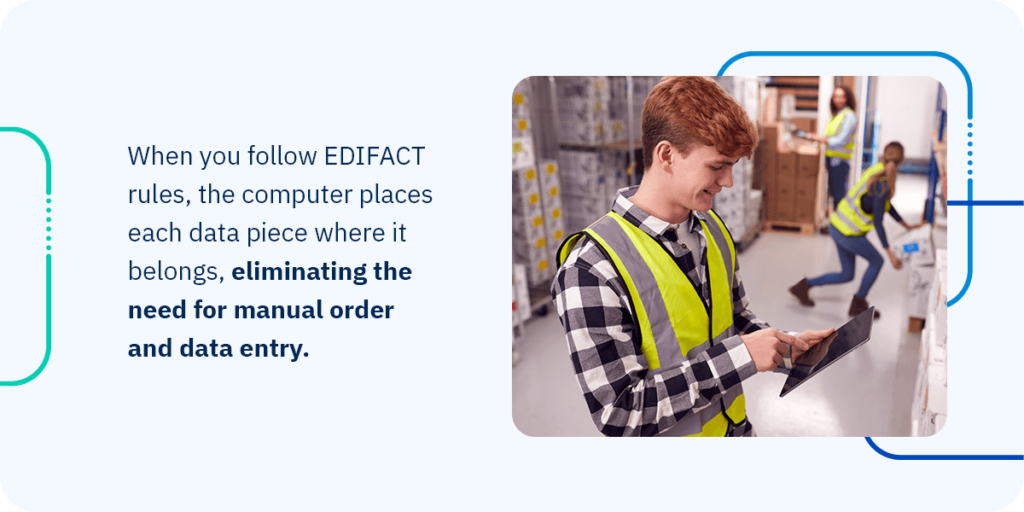EDIFACT Transaction Sets (UK)

EDIFACT is the most common European EDI standard and as a result many European companies must follow the EDIFACT standard for EDI communication to ensure efficiency, accurate communication, and system protection. European companies must follow the EDIFACT standard for EDI communications to ensure efficiency, accurate communication, and system protection.
Guide to EDIFACT Transaction Sets
EDIFACT EDI sends information via transaction codes in standardized document formats. It eliminates the need for manual processes and paper-based tasks, allowing businesses to automate transaction communications for improved efficiency and accuracy. Companies use EDI to send and receive documents such as the following:
- Invoices
- Shipping information
- Purchase orders
- Advance shipping notices
In EDI communication, business documents are ‘messages’ or ‘transaction sets.’ Each document or set consists of the following components.
Data Elements
Data elements are a document’s separate pieces of information. For example, a shipping order may contain the item number, shipping address, price, and quantity. EDIFACT defines each of a transaction’s data elements by type. The following data element descriptions help receiving computer systems distinguish between different information:
- Data type
- Code values
- Maximum or minimum length
A data type can be text, numeric, date, time, or alphanumeric. It’s essential to distinguish between elements like calendar dates, alphanumeric addresses, and numerical prices. You must observe code values in particular data types. For example, codes represent the currency you use in a unit cost field, such as euros or USD. Maximum or minimum length is also known as the data range, and it refers to the number of available character positions to represent a data element.
Segments
A segment comprises data elements, combining them into an organized group of related data. Each segment within an EDI document describes a particular section. A three-character code such as NAD, BGM, UNS, or CNT begins a segment and represents the data element type that follows. Data element separators distinguish each piece of information with a symbol like an apostrophe or plus sign.
Envelope
An envelope houses a transaction set, and pairs of segments form envelopes to define section beginnings and ends. The following types of envelopes are part of EDI communication and use different segments.
- Message: Each transaction set resides in an individual envelope. Message or transaction set envelopes begin with the UNH segment and end with the UNT segment.
- Group: A transaction set group, such as a group of invoices, typically goes into a group envelope. While this is mandatory in the United States ANSI EDI standard, it is optional in the EDIFACT standard. A group envelope begins with the UNG segment and ends with the UNE segment.
- Interchange: An interchange envelope holds all of a transaction’s group envelopes. Interchange envelopes begin with a UNA or UNB segment and end with a UNZ segment.
Importance of Trading Partner Compliance Requirements
You must follow strict formatting rules when creating an EDI document. The country or industry you work in determines the specific standard you use, and many businesses in the UK use a set of standards known as EDIFACT. This EDI protocol replaced the former European EDI standard known as Tradacoms. While some retail businesses in the UK still use Tradacoms for EDI transactions, EDIFACT is the primary standard most European companies use, and it defines the following rules:
- Which segments are mandatory, conditional, or optional
- Which elements you may include
- The required elements and segments sequence
- How many times you may repeat a segment
EDIFACT’s specific rules define how and where to find each of a document’s components. This protocol ensures a receiving computer’s translator can read the document correctly and immediately understand where to find information such as the following:
- Purchase order number
- Buyer’s and seller’s company names
- Order items and their prices
When you follow EDIFACT rules, the receiving computer’s order entry system automatically collects the data in the correct internal format. This system ensures the computer places each data piece where it belongs, eliminating the need for manual order and data entry. Guidelines also protect the EDI communication system from internal breakdown and corruption.

Main EDIFACT Features
The EDIFACT standard ensures companies organize EDI elements for accuracy and efficiency. It includes these primary features.
- Syntax rules: Syntax rules are grammatical standards that ensure uniform message structures.
- Data element directories: Data element directories serve as the vocabulary companies use to represent information.
- Standard messaging: EDIFACT establishes standard messages for multi-industry and multi-country exchanges to ensure clear communication and efficient data flow.
- Interactive Exchange Protocol: The Interactive Exchange Protocol provides direct and dynamic dialogue companies use to communicate. This protocol shortens response times.
Common EDIFACT Transaction Codes
Numerous EDIFACT transaction codes make up this EDI language, and we have listed some of the most prevalent ones below.
- APERAK: Application Error and Acknowledgement
- AUTACK: Secure Authentication and Acknowledgement Message
- AUTHOR: Authorization Message
- BANSTA: Banking Status
- BAPLIE: Bayplan/Stowage Plan Occupied and Empty Locations Message
- BAPLTE: Bayplan/Stowage Plan Total Numbers
- BOPBNK: Bank Transactions and Portfolio Transactions Report
- BOPCUS: Balance of Payment Customer Transaction Report
- BOPDIR: Direct Balance of Payment Declaration
- BOPINF: Balance of Payment Information From Customer
- CUSPED: Periodic Customs Declaration
- CUSREP: Customs Conveyance Report Message
- DEBADV: Debit Advice Message
- DEBMUL: Multiple Debit Advice
- FINCAN: Financial Cancellation
- FINSTA: Financial Statement of an Account
- GENRAL: General Purpose
- HANMOV: Cargo/Goods Handling and Movement
- IFCSUM: Forwarding and Consolidation Summary Message
- JAPRES: Job Application Result
- JOBMOD: Job Order Modification Message
- MEDPID: Person Identification Message
- MEDREQ: Medical Service Request
- ORDCHG: Purchase Order Change Request Message
- PRODAT: Product Data
- PRODEX: Product Exchange Reconciliation
- RECADV: Receiving Advice
- RECALC: Reinsurance Calculation
- RECECO: Credit Risk Cover
- RECLAM: Reinsurance Claims
- REMADV: Remittance Advice Message
- REPREM: Reinsurance Premium
- REQOTE: Request for Quote Message
- RESETT: Reinsurance Settlement
- RESMSG: Reservation
- RETACC: Reinsurance Technical Account
- RETANN: Announcement for Returns
- SANCRT: Sanitary/Phytosanitary Certificate
- SSIMOD: Modification of Identity Details Message
- SSRECH: Worker’s Insurance History Message
- SSREGW: Notification of Registration of a Worker
- SUPCOT: Superannuation Contributions Advice Message
- SUPMAN: Superannuation Maintenance Message
- STATAC: Statement of Account Message
- TANSTA: Tank Status Report
- VATDEC: Value-Added Tax
- VESDEP: Vessel Departure
- WASDIS: Waste Disposal Information
- WKGRDC: Work Grant Decision Message
- WKGRRE: Work Grant Request Message
Outsource Your EDI Communication with TrueCommerce

The EDIFACT standard provides the necessary framework to perform EDI communication safely and efficiently. Rest assured that your transactions are efficient and comply with EDIFACT regulations with our innovative EDI tools.
TrueCommerce addresses your EDI needs with reliable solutions that connect directly to your enterprise resource planning system. Our platform handles transactions efficiently and eliminates the need for manual data input and client interaction. Contact us to book a demo and learn more about our fully managed and automated EDI service.